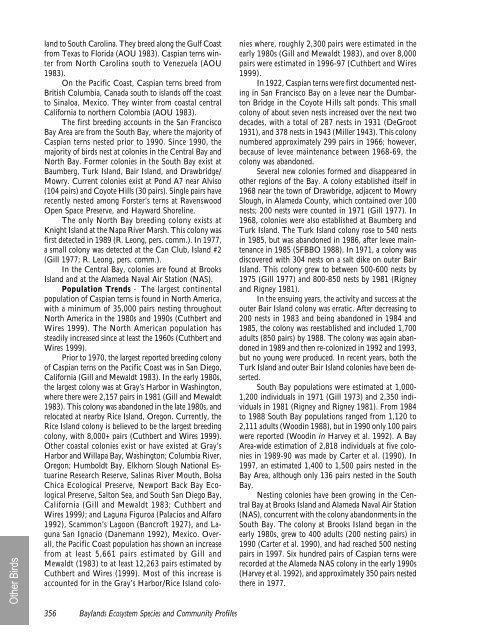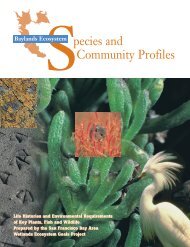Species and Community Profiles - San Francisco Estuary ...
Species and Community Profiles - San Francisco Estuary ...
Species and Community Profiles - San Francisco Estuary ...
You also want an ePaper? Increase the reach of your titles
YUMPU automatically turns print PDFs into web optimized ePapers that Google loves.
Other Birds<br />
l<strong>and</strong> to South Carolina. They breed along the Gulf Coast<br />
from Texas to Florida (AOU 1983). Caspian terns winter<br />
from North Carolina south to Venezuela (AOU<br />
1983).<br />
On the Pacific Coast, Caspian terns breed from<br />
British Columbia, Canada south to isl<strong>and</strong>s off the coast<br />
to Sinaloa, Mexico. They winter from coastal central<br />
California to northern Colombia (AOU 1983).<br />
The first breeding accounts in the <strong>San</strong> <strong>Francisco</strong><br />
Bay Area are from the South Bay, where the majority of<br />
Caspian terns nested prior to 1990. Since 1990, the<br />
majority of birds nest at colonies in the Central Bay <strong>and</strong><br />
North Bay. Former colonies in the South Bay exist at<br />
Baumberg, Turk Isl<strong>and</strong>, Bair Isl<strong>and</strong>, <strong>and</strong> Drawbridge/<br />
Mowry. Current colonies exist at Pond A7 near Alviso<br />
(104 pairs) <strong>and</strong> Coyote Hills (30 pairs). Single pairs have<br />
recently nested among Forster’s terns at Ravenswood<br />
Open Space Preserve, <strong>and</strong> Hayward Shoreline.<br />
The only North Bay breeding colony exists at<br />
Knight Isl<strong>and</strong> at the Napa River Marsh. This colony was<br />
first detected in 1989 (R. Leong, pers. comm.). In 1977,<br />
a small colony was detected at the Can Club, Isl<strong>and</strong> #2<br />
(Gill 1977; R. Leong, pers. comm.).<br />
In the Central Bay, colonies are found at Brooks<br />
Isl<strong>and</strong> <strong>and</strong> at the Alameda Naval Air Station (NAS).<br />
Population Trends – The largest continental<br />
population of Caspian terns is found in North America,<br />
with a minimum of 35,000 pairs nesting throughout<br />
North America in the 1980s <strong>and</strong> 1990s (Cuthbert <strong>and</strong><br />
Wires 1999). The North American population has<br />
steadily increased since at least the 1960s (Cuthbert <strong>and</strong><br />
Wires 1999).<br />
Prior to 1970, the largest reported breeding colony<br />
of Caspian terns on the Pacific Coast was in <strong>San</strong> Diego,<br />
California (Gill <strong>and</strong> Mewaldt 1983). In the early 1980s,<br />
the largest colony was at Gray’s Harbor in Washington,<br />
where there were 2,157 pairs in 1981 (Gill <strong>and</strong> Mewaldt<br />
1983). This colony was ab<strong>and</strong>oned in the late 1980s, <strong>and</strong><br />
relocated at nearby Rice Isl<strong>and</strong>, Oregon. Currently, the<br />
Rice Isl<strong>and</strong> colony is believed to be the largest breeding<br />
colony, with 8,000+ pairs (Cuthbert <strong>and</strong> Wires 1999).<br />
Other coastal colonies exist or have existed at Gray’s<br />
Harbor <strong>and</strong> Willapa Bay, Washington; Columbia River,<br />
Oregon; Humboldt Bay, Elkhorn Slough National Estuarine<br />
Research Reserve, Salinas River Mouth, Bolsa<br />
Chica Ecological Preserve, Newport Back Bay Ecological<br />
Preserve, Salton Sea, <strong>and</strong> South <strong>San</strong> Diego Bay,<br />
California (Gill <strong>and</strong> Mewaldt 1983; Cuthbert <strong>and</strong><br />
Wires 1999); <strong>and</strong> Laguna Figuroa (Palacios <strong>and</strong> Alfaro<br />
1992), Scammon’s Lagoon (Bancroft 1927), <strong>and</strong> Laguna<br />
<strong>San</strong> Ignacio (Danemann 1992), Mexico. Overall,<br />
the Pacific Coast population has shown an increase<br />
from at least 5,661 pairs estimated by Gill <strong>and</strong><br />
Mewaldt (1983) to at least 12,263 pairs estimated by<br />
Cuthbert <strong>and</strong> Wires (1999). Most of this increase is<br />
accounted for in the Gray’s Harbor/Rice Isl<strong>and</strong> colo-<br />
356 Bayl<strong>and</strong>s Ecosystem <strong>Species</strong> <strong>and</strong> <strong>Community</strong> <strong>Profiles</strong><br />
nies where, roughly 2,300 pairs were estimated in the<br />
early 1980s (Gill <strong>and</strong> Mewaldt 1983), <strong>and</strong> over 8,000<br />
pairs were estimated in 1996-97 (Cuthbert <strong>and</strong> Wires<br />
1999).<br />
In 1922, Caspian terns were first documented nesting<br />
in <strong>San</strong> <strong>Francisco</strong> Bay on a levee near the Dumbarton<br />
Bridge in the Coyote Hills salt ponds. This small<br />
colony of about seven nests increased over the next two<br />
decades, with a total of 287 nests in 1931 (DeGroot<br />
1931), <strong>and</strong> 378 nests in 1943 (Miller 1943). This colony<br />
numbered approximately 299 pairs in 1966; however,<br />
because of levee maintenance between 1968-69, the<br />
colony was ab<strong>and</strong>oned.<br />
Several new colonies formed <strong>and</strong> disappeared in<br />
other regions of the Bay. A colony established itself in<br />
1968 near the town of Drawbridge, adjacent to Mowry<br />
Slough, in Alameda County, which contained over 100<br />
nests; 200 nests were counted in 1971 (Gill 1977). In<br />
1968, colonies were also established at Baumberg <strong>and</strong><br />
Turk Isl<strong>and</strong>. The Turk Isl<strong>and</strong> colony rose to 540 nests<br />
in 1985, but was ab<strong>and</strong>oned in 1986, after levee maintenance<br />
in 1985 (SFBBO 1988). In 1971, a colony was<br />
discovered with 304 nests on a salt dike on outer Bair<br />
Isl<strong>and</strong>. This colony grew to between 500-600 nests by<br />
1975 (Gill 1977) <strong>and</strong> 800-850 nests by 1981 (Rigney<br />
<strong>and</strong> Rigney 1981).<br />
In the ensuing years, the activity <strong>and</strong> success at the<br />
outer Bair Isl<strong>and</strong> colony was erratic. After decreasing to<br />
200 nests in 1983 <strong>and</strong> being ab<strong>and</strong>oned in 1984 <strong>and</strong><br />
1985, the colony was reestablished <strong>and</strong> included 1,700<br />
adults (850 pairs) by 1988. The colony was again ab<strong>and</strong>oned<br />
in 1989 <strong>and</strong> then re-colonized in 1992 <strong>and</strong> 1993,<br />
but no young were produced. In recent years, both the<br />
Turk Isl<strong>and</strong> <strong>and</strong> outer Bair Isl<strong>and</strong> colonies have been deserted.<br />
South Bay populations were estimated at 1,000-<br />
1,200 individuals in 1971 (Gill 1973) <strong>and</strong> 2,350 individuals<br />
in 1981 (Rigney <strong>and</strong> Rigney 1981). From 1984<br />
to 1988 South Bay populations ranged from 1,120 to<br />
2,111 adults (Woodin 1988), but in 1990 only 100 pairs<br />
were reported (Woodin in Harvey et al. 1992). A Bay<br />
Area-wide estimation of 2,818 individuals at five colonies<br />
in 1989-90 was made by Carter et al. (1990). In<br />
1997, an estimated 1,400 to 1,500 pairs nested in the<br />
Bay Area, although only 136 pairs nested in the South<br />
Bay.<br />
Nesting colonies have been growing in the Central<br />
Bay at Brooks Isl<strong>and</strong> <strong>and</strong> Alameda Naval Air Station<br />
(NAS), concurrent with the colony ab<strong>and</strong>onments in the<br />
South Bay. The colony at Brooks Isl<strong>and</strong> began in the<br />
early 1980s, grew to 400 adults (200 nesting pairs) in<br />
1990 (Carter et al. 1990), <strong>and</strong> had reached 500 nesting<br />
pairs in 1997. Six hundred pairs of Caspian terns were<br />
recorded at the Alameda NAS colony in the early 1990s<br />
(Harvey et al. 1992), <strong>and</strong> approximately 350 pairs nested<br />
there in 1977.



